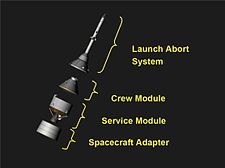
Back Orion (nau espacial) AN أوريون (مركبة فضاء) Arabic Арыён (касмічны карабель) Byelorussian Орион (космически кораб) Bulgarian ওরায়ন (মহাকাশযান) Bengali/Bangla Orion (nau espacial) Catalan Orion (kosmická loď) Czech Orion (rumfartøj) Danish Orion (Raumschiff) German Orion Greek
 An artist's picture of the Orion spacecraft | |
| Manufacturer | Lockheed Martin Airbus |
|---|---|
| Country of origin | United States of America |
| Operator | NASA |
| Applications | Beyond LEO exploration[1] |
| Specifications | |
| Spacecraft type | Space capsule |
| Design life | 21 days, 2 hours and 24 minutes[2] |
| Launch mass | Capsule: 10,387 kilograms (22,899 pounds) Service module: 15,461 kilograms (34,086 pounds) Total: 25,848 kilograms (56,985 pounds) |
| Crew capacity | 2–6[3] |
| Dimensions | 3.3 by 5 metres (11 by 16 feet) |
| Volume | Pressurized: 19.56 kilometres (12.15 miles)[4] Habitable: 8.95 m3 (316 cu ft) |
| Production | |
| Launched | 2 |
| First launch | December 5, 2014 |
| Related spacecraft | |
| Derived from | |

Orion, full name: Orion Multi-Purpose Crew Vehicle or Orion MPCV, is a spacecraft built by Lockheed Martin for NASA.
One of those flew into space (and back to Earth), as late as 2022's fourth quarter. That mission lasted 25 days. There were no astronauts on the flight.
A spaceflight with astronauts is planned for, no earlier than 2025's third quarter.
Each Orion spacecraft will be able to carry up to six[3] astronauts. The Orion vehicle will be launched on the Space Launch System.[5] The first launch (Exploration Flight Test-1) was on the Delta IV Heavy.[6]
Orion is meant to take humans to the Moon and Mars.
- ↑ "NASA Authorization Act of 2010". Thomas.loc.gov. Archived from the original on December 19, 2010. Retrieved November 20, 2010.
- ↑ Bergin, Chris (July 10, 2012). "NASA ESD set key Orion requirement based on Lunar missions". NASASpaceFlight.com. Retrieved July 23, 2012.
- ↑ 3.0 3.1 Moskowitz, Clara (November 2014). "Deep Space or Bust". Scientific American. 311 (6): 20. Bibcode:2014SciAm.311f..20M. doi:10.1038/scientificamerican1214-20.
- ↑ "Orion Quick facts" (PDF). NASA. August 4, 2014. Archived from the original (PDF) on June 3, 2016. Retrieved October 29, 2015.
- ↑ "Preliminary Report Regarding NASA's Space Launch System and Multi-Purpose Crew Vehicle" (PDF). NASA. January 2011. Retrieved June 18, 2011.
- ↑ Fountain, Henry (December 5, 2014). "NASA's Orion Spacecraft Splashes Down in Pacific After Test Flight". New York Times. Retrieved December 5, 2014.